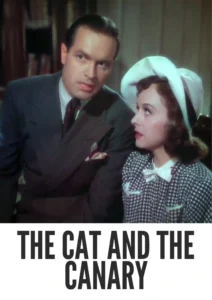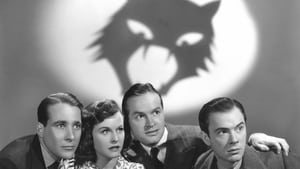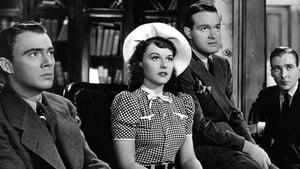Contact: info@alwanfilm.com
Video Sources 0 Views
- Watch trailer
- The Cat and the Canary 1939


Synopsis
Table of Contents
ToggleReview: The Cat and the Canary 1939 Colorized – A Classic Mystery Thriller Revived in Vivid Color

Introduction
“The Cat and the Canary” (1939) is a gripping mystery thriller that continues to captivate audiences with its timeless suspense and intrigue. In this article, we’ll explore the significance of this early colored film, delving into its impact on cinematic history and its enduring appeal to modern audiences.
Check The Full Colorized Movies List
Check Our Colorized Movies Trailer Channel
Understanding The Cat and the Canary 1939 Colorized: Director, Cast, and Genre
Directed by the renowned Elliott Nugent, “The Cat and the Canary” (1939) showcases his mastery of suspense and atmosphere, creating a hauntingly atmospheric world that keeps viewers on the edge of their seats. The film boasts a talented cast, including Bob Hope, Paulette Goddard, and John Beal, whose performances bring the story to life with palpable tension and excitement. Blending elements of horror, comedy, and romance, “The Cat and the Canary” (1939) offers a thrilling ride through a maze of secrets and deception.
Exploring the World of The Cat and the Canary 1939 Colorized: Plot and Characters
At its core, “The Cat and the Canary” (1939) follows the unraveling mystery of a family inheritance, as a group of heirs gathers at a secluded mansion for the reading of a will. As tensions rise and secrets are revealed, the characters find themselves caught in a web of intrigue and danger, with sinister forces lurking in the shadows. With its eerie atmosphere and spine-tingling suspense, “The Cat and the Canary” (1939) keeps audiences guessing until the very end.
The Art of Film Colorization
Film colorization is a transformative technique that adds depth and vibrancy to classic movies, breathing new life into timeless stories and allowing viewers to experience them in a fresh and exciting way. By digitally enhancing the color palette of black and white films, colorization opens up new possibilities for storytelling and visual expression, inviting audiences to rediscover their favorite movies in stunning detail.
Early Colored Films: A Brief History
The history of colored films stretches back to the early days of cinema, with filmmakers experimenting with various techniques to add color to their creations. From hand-tinted frames to early Technicolor processes, the evolution of colored film has been marked by innovation and creativity, laying the groundwork for the development of modern colorization techniques that continue to captivate audiences to this day.
The Cat and the Canary 1939 and Its Early Colored Version
The decision to release “The Cat and the Canary” (1939) in a colorized format was met with both excitement and skepticism. While some welcomed the opportunity to experience the film in vibrant color, others expressed concerns about the potential impact on its visual aesthetic. Nevertheless, the early colored version of “The Cat and the Canary” (1939) offers viewers a fresh perspective on the classic mystery thriller, enhancing its atmosphere and immersing audiences in its haunting world of secrets and suspense.
The Debate Over Film Colorization
The debate over film colorization continues to divide audiences and critics alike, with proponents praising its ability to breathe new life into classic movies and introduce them to a new generation of viewers, while detractors argue that it compromises the artistic integrity of the original work and diminishes its historical significance. As the debate rages on, filmmakers and audiences alike are left to ponder the merits and drawbacks of colorization in the ever-evolving landscape of cinema.
Examining The Cat and the Canary 1939 as an Early Colored Film
As with any colorized classic, the impact of colorization on “The Cat and the Canary” (1939) is a matter of personal interpretation. Some may argue that it enhances the film’s visual appeal and immerses viewers in its world, while others may feel that it detracts from the stark beauty of the original black and white version. Regardless of one’s stance on the issue, there’s no denying the enduring power of “The Cat and the Canary” (1939) as a timeless mystery thriller that continues to thrill and delight audiences around the world.
Influence and Legacy: The Cat and the Canary 1939 Colorized’s Impact on Cinema
“The Cat and the Canary” (1939) has left an indelible mark on the world of cinema, inspiring countless filmmakers and captivating audiences with its timeless tale of mystery and suspense. From its chilling atmosphere to its unforgettable characters, the film continues to resonate with viewers of all ages, reaffirming its status as a beloved classic of the mystery thriller genre.
Director’s Cinematic Legacy: Beyond The Cat and the Canary 1939 Colorized
Elliott Nugent’s influence extends far beyond “The Cat and the Canary” (1939), with a diverse body of work that continues to captivate audiences around the globe. From “My Favorite Brunette” to “The Male Animal,” Nugent’s films are celebrated for their wit, charm, and inventive storytelling, solidifying his legacy as one of the preeminent directors of Hollywood’s Golden Age. Through his groundbreaking work, Nugent has left an indelible imprint on the world of cinema, inspiring generations of filmmakers to follow in his footsteps.
Themes Explored in The Cat and the Canary 1939 Colorized
“The Cat and the Canary” (1939) explores a myriad of themes, from the nature of fear and paranoia to the complexities of family and inheritance. Through its richly drawn characters and atmospheric setting, the film invites viewers to confront their deepest fears and unravel the mysteries that lie beneath the surface. As audiences immerse themselves in the world of “The Cat and the Canary” (1939), they are reminded of the timeless truths that bind us together and the enduring power of storytelling to transport us to places beyond our wildest imagination.
Reception and Controversy Surrounding The Cat and the Canary 1939 Colorized
Upon its release, “The Cat and the Canary” (1939) received widespread critical acclaim, with many praising its chilling atmosphere, gripping suspense, and unforgettable performances. However, the decision to release the film in a colorized format sparked debate among purists, reigniting the age-old discussion surrounding film preservation and artistic integrity. Despite the controversy, “The Cat and the Canary” (1939) remains a beloved classic that continues to thrill and delight audiences of all ages, reaffirming its status as a timeless masterpiece of the mystery thriller genre.
Where to Watch The Cat and the Canary 1939 Colorized Online
For those eager to experience the timeless suspense of “The Cat and the Canary” (1939), the film is readily available on popular streaming platforms such as Netflix, Amazon Prime, and Hulu. Whether you choose to watch it in its original black and white format or the early colored version, “The Cat and the Canary” (1939) promises to keep you on the edge of your seat with its spine-tingling suspense and unforgettable thrills.
FAQs About The Cat and the Canary 1939 Colorized
Q: Is “The Cat and the Canary” (1939) based on a true story? A: No, “The Cat and the Canary” (1939) is a fictional mystery thriller inspired by the play of the same name by John Willard.
Q: Who are the main actors in “The Cat and the Canary” (1939)? A: “The Cat and the Canary” (1939) features a talented ensemble cast, including Bob Hope, Paulette Goddard, and John Beal, whose performances bring the story to life with palpable tension and excitement.
Q: What awards did “The Cat and the Canary” (1939) win? A: While “The Cat and the Canary” (1939) did not win any major awards, it received critical acclaim for its atmospheric setting, gripping suspense, and unforgettable performances.
Q: Why was “The Cat and the Canary” (1939) released in a colorized format? A: The decision to release “The Cat and the Canary” (1939) in color was made to introduce the film to a new generation of viewers and enhance its visual appeal for modern audiences. While the choice to colorize the film sparked debate among purists, it ultimately allowed “The Cat and the Canary” (1939) to reach a wider audience and ensure its continued relevance in the annals of cinematic history.
Conclusion
“The Cat and the Canary” (1939) remains a timeless masterpiece of the mystery thriller genre, captivating audiences with its chilling atmosphere, gripping suspense, and unforgettable performances. Whether viewed in its original black and white format or the early colored version, the film continues to thrill and delight audiences of all ages, reaffirming its status as a timeless classic that stands the test of time.












